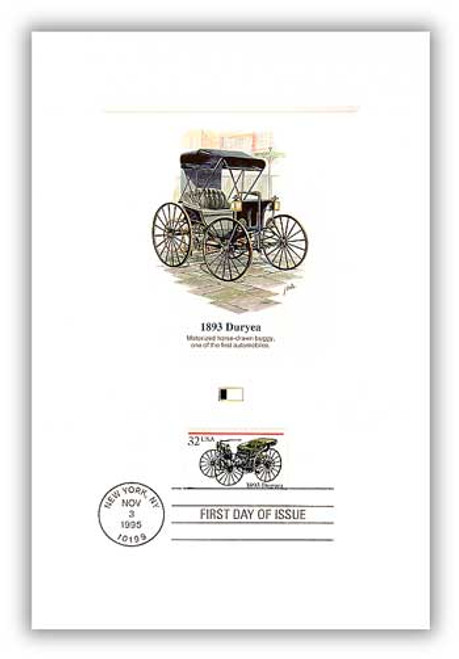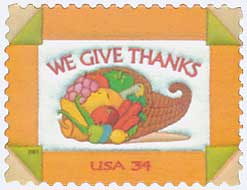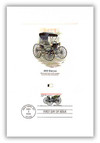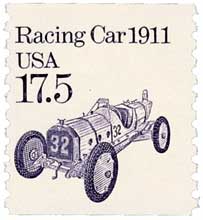
# 4904494 FDC - 1995 Antique Auto-1893 Duryea Proofcard
The Duryea brothers were two of America’s greatest automobile pioneers. Charles E. Duryea and J. Frank Duryea built the first successful gasoline-powered car in the United States. This prototype car was a powered horse buggy, with a single-cylinder four horsepower engine and friction drive. Frank Duryea built a second car, and with it, took first place in America’s first automobile race – the Chicago Times Herald race, which was held on Thanksgiving Day. Only one other car finished the 50-mile race. The Duryea brothers collected the first-place prize of $2,000 for their speedy performance – their car averaged 7 miles per hour!
Â
In 1895 the brothers formed the Springfield, Massachusetts-based Duryea Motor Wagon Company. Thirteen cars were produced by this enterprise in 1896. Frank Duryea left the company and joined Stevens Arms Company in 1898. There he designed four-cylinder and six-cylinder Stevens-Duryea automobiles.
Â
Charles Duryea went on to form three other successful commercial automobile interests: Duryea Mfg. Co., based in Peoria, Illinois (1896-1898); Duryea Power Co., located in Reading, Pennsylvania (1899-1908); and Duryea Motor Co., based in Saginaw, Michigan (1908-1913).
America’s First Automobile RaceÂ
Months earlier, on July 10, 1895, the Chicago Times-Herald first announced that they would hold a race through the city. A prize of $5,000 ($688,000 in today’s wages) was up for grabs. The paper had planned the race as a way to accelerate the still-young automotive industry in America. America’s first automobiles were produced just two years earlier, and the paper wasn’t even sure what to call them. They ultimately decided on “Moto-Cycle.â€
Â
The original route for the race led from Chicago to Milwaukee, but they discovered the roads selected would be too difficult for cars to travel. Instead they settled on a 54-mile route from Chicago to Evanston and back. The finish line would be at the Palace of Fine Arts from the 1893 Columbian Exposition (today’s Chicago Museum of Science and History).

The race was planned to be held on November 2, 1895, but not many cars showed up. It was then rescheduled. In all, 83 cars were initially entered into the race. However, most of the drivers didn’t have their cars done in time or were unable to make the trip to Chicago. An early favorite, Elwood Haynes, was unable to make the trip when his car was damaged on the way there. Police stopped him and another driver when they made their way into Chicago. The police insisted that they use horses to pull their cars, because they didn’t have the right to drive their vehicles on the city’s streets. This forced the race to again be postponed. The paper’s editors then address city leaders and convinced them to get an ordinance passed giving them the right to drive on the streets. With that obstacle cleared, they set the date of the race for Thanksgiving Day, November 28.

The day of the race was snowy with 38-degree temperatures. A German car made by Karl Benz was the first to arrive. There were two other Benz cars that arrived and participated in the race. There was also Charles Duryea and his motorized wagon as well as two other drivers with their two-wheeled vehicles. Another car that arrived that day was electric, but its battery died from the cold weather.

The race began at 8:55 that morning and shortly after one of Benz’s cars hit a horse and had to leave the race. Duryea took an early lead, but his left front wheel got stuck and broke off the steering arm. He quickly stopped at a blacksmith shop and got a replacement arm and continued on the race. Though one of the Benz cars took the lead during this time, Duryea caught up and regained the lead on the return trip from Evanston.

Then along the way two of Duryea’s cylinders stopped firing. He stopped for about 55 minutes to repair his car, and was sure he had lost the race. But as he drove through unpacked snow, he realized all the other racers were still behind him. Duryea stopped for gas and a passing train, but still managed to cross the finish line first at 7:18 p.m. Only one other car managed to cross the finish line, the Mueller Benz. But its driver, Mr. Mueller, had passed out from exhaustion and someone else drove it across the finish line.
Stories of the race were published in newspaper across the country. Soon many speculated that these vehicles, which could travel even in harsh weather, would soon replace horse-drawn vehicles. Some credit this race with speeding up the development of the automobile in America by at least five years.
Click here for an article about the race.
The Duryea brothers were two of America’s greatest automobile pioneers. Charles E. Duryea and J. Frank Duryea built the first successful gasoline-powered car in the United States. This prototype car was a powered horse buggy, with a single-cylinder four horsepower engine and friction drive. Frank Duryea built a second car, and with it, took first place in America’s first automobile race – the Chicago Times Herald race, which was held on Thanksgiving Day. Only one other car finished the 50-mile race. The Duryea brothers collected the first-place prize of $2,000 for their speedy performance – their car averaged 7 miles per hour!
Â
In 1895 the brothers formed the Springfield, Massachusetts-based Duryea Motor Wagon Company. Thirteen cars were produced by this enterprise in 1896. Frank Duryea left the company and joined Stevens Arms Company in 1898. There he designed four-cylinder and six-cylinder Stevens-Duryea automobiles.
Â
Charles Duryea went on to form three other successful commercial automobile interests: Duryea Mfg. Co., based in Peoria, Illinois (1896-1898); Duryea Power Co., located in Reading, Pennsylvania (1899-1908); and Duryea Motor Co., based in Saginaw, Michigan (1908-1913).
America’s First Automobile RaceÂ
Months earlier, on July 10, 1895, the Chicago Times-Herald first announced that they would hold a race through the city. A prize of $5,000 ($688,000 in today’s wages) was up for grabs. The paper had planned the race as a way to accelerate the still-young automotive industry in America. America’s first automobiles were produced just two years earlier, and the paper wasn’t even sure what to call them. They ultimately decided on “Moto-Cycle.â€
Â
The original route for the race led from Chicago to Milwaukee, but they discovered the roads selected would be too difficult for cars to travel. Instead they settled on a 54-mile route from Chicago to Evanston and back. The finish line would be at the Palace of Fine Arts from the 1893 Columbian Exposition (today’s Chicago Museum of Science and History).

The race was planned to be held on November 2, 1895, but not many cars showed up. It was then rescheduled. In all, 83 cars were initially entered into the race. However, most of the drivers didn’t have their cars done in time or were unable to make the trip to Chicago. An early favorite, Elwood Haynes, was unable to make the trip when his car was damaged on the way there. Police stopped him and another driver when they made their way into Chicago. The police insisted that they use horses to pull their cars, because they didn’t have the right to drive their vehicles on the city’s streets. This forced the race to again be postponed. The paper’s editors then address city leaders and convinced them to get an ordinance passed giving them the right to drive on the streets. With that obstacle cleared, they set the date of the race for Thanksgiving Day, November 28.

The day of the race was snowy with 38-degree temperatures. A German car made by Karl Benz was the first to arrive. There were two other Benz cars that arrived and participated in the race. There was also Charles Duryea and his motorized wagon as well as two other drivers with their two-wheeled vehicles. Another car that arrived that day was electric, but its battery died from the cold weather.

The race began at 8:55 that morning and shortly after one of Benz’s cars hit a horse and had to leave the race. Duryea took an early lead, but his left front wheel got stuck and broke off the steering arm. He quickly stopped at a blacksmith shop and got a replacement arm and continued on the race. Though one of the Benz cars took the lead during this time, Duryea caught up and regained the lead on the return trip from Evanston.

Then along the way two of Duryea’s cylinders stopped firing. He stopped for about 55 minutes to repair his car, and was sure he had lost the race. But as he drove through unpacked snow, he realized all the other racers were still behind him. Duryea stopped for gas and a passing train, but still managed to cross the finish line first at 7:18 p.m. Only one other car managed to cross the finish line, the Mueller Benz. But its driver, Mr. Mueller, had passed out from exhaustion and someone else drove it across the finish line.
Stories of the race were published in newspaper across the country. Soon many speculated that these vehicles, which could travel even in harsh weather, would soon replace horse-drawn vehicles. Some credit this race with speeding up the development of the automobile in America by at least five years.
Click here for an article about the race.














